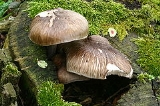
Pluteus cervinus
Encyclopedia
Pluteus cervinus, also known as Pluteus atricapillus and commonly
known as the deer shield or the deer or fawn mushroom, is a mushroom that belongs to the large genus Pluteus
. It is found on rotten logs, roots and tree stumps and is widely distributed. It can also grow on sawdust and other wood waste. Being very variable in appearance, it has been divided into several varieties or subspecies, some of which are sometimes considered species in their own right. It is edible, but not often collected for the table.
Common name
A common name of a taxon or organism is a name in general use within a community; it is often contrasted with the scientific name for the same organism...
known as the deer shield or the deer or fawn mushroom, is a mushroom that belongs to the large genus Pluteus
Pluteus
Pluteus is a large genus of fungi with over 100 species. They are wood rotting saprobes with pink spore prints and gills that are free from the stem.Pluteus means shed or penthouse.-Characteristics of the genus :...
. It is found on rotten logs, roots and tree stumps and is widely distributed. It can also grow on sawdust and other wood waste. Being very variable in appearance, it has been divided into several varieties or subspecies, some of which are sometimes considered species in their own right. It is edible, but not often collected for the table.
Description
- The species name, cervinus, although generally thought to refer to the colour of the cap, actually refers to antler-like protrusions on its prominent thick-walled pleurocystidia (of which there can be one to three).
- The spore size is approx. 8×5μ.
- The cap can be deer-brown, but vary from light ochre-brown to dark brown, with a variable admixture of grey or black. The centre of the cap may be darker.
- The cap can be up to 15 cm in diameter, but is often much smaller. Initially it is bell-shaped, and often wrinkled when young. Later it expands to a convex shape.
- The cap surface is smooth and matt to silky-reflective. The cap skin shows dark radial fibres when seen through a lens, indicating that the microscopic cuticle structure is filamentous.
- The spore print is salmon-pink to reddish-brown. The gills are initially white, but soon show a distinctive pinkish sheen, caused by the ripening spores.
- The stipe is 5-12 cm long and 0.7-2.0 cm in diameter, usually thicker at the base. It is covered with brown vertical fibrils on a white ground.
- The flesh is soft and white. The mushroom has a mild to earthy radish smell and a mild taste at first, which may become slightly bitter.
- It grows on dead wood or wood remains.

